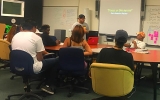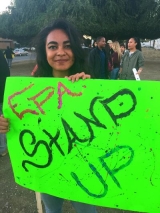Students with Amazing Goals helps struggling youth succeed in school and beyond.

Nikko Jackson, left, a case manager at Live in Peace, works with a student aiming to graduate from high school. The SWAG program seeks to re-engage students at risk of dropping out in school and to see a positive future for themselves and their community.
She is a promising student with plans “to attend the college of my dreams” but has fallen far behind after she had to skip school in order to care for her ailing parents.
There’s a boy with a father “straight out of jail” and a mother who’s a “booster,” slang for someone who steals from stores and sells items on the street for quick cash. He’s missed months of school.
There’s a girl who loves to sing and is part of a choir but runs with “a very misguided crew of friends” looking to cause trouble rather than attend class.
Accounts like these, gathered from interviews with teenagers and counselors and case workers, are common at Students with Amazing Goals (SWAG), which provides at-risk students from East Palo Alto and Menlo Park with academic support and the resources they need to succeed academically.
SWAG was launched in 2015 to help increase the graduation rates of students from areas that experience some of the highest levels of economic and educational inequality in the County of San Mateo. The high school graduation rate in the area is 55 percent, the lowest in the county.

“It’s more than keeping kids in school. It’s community development,” said Bob Hoover, a long-time East Palo Alto resident and a SWAG counselor. “When you have a high dropout rate, the impact on the long-term growth, development and health of the community is huge.”
Bob Hoover attended graduate school at both UC Berkeley and Stanford. Comments from students about his clashing wardrobe gives him an opening to start a conversation about college and the future.
The future can be bleak for high school dropouts: they face far higher rates of unemployment, earn lower wages when they do find work and are far more likely to end up in the criminal justice system and on public assistance than peers with a high school diploma or a bachelor’s degree.
On any given day, about one in every 10 young male high school dropouts is in jail, prison or juvenile detention, versus fewer than one in 33 young male high school graduates, according to a study by Northeastern University. Young high school dropouts are nearly nine times as likely to have become single mothers as their counterparts with bachelor degrees. More than a third of young women without a high school diploma live in poverty and are therefore more likely to rely on public assistance.
Funding for SWAG comes from a three-year federal grant and $350,000 from Measure K, the countywide half-cent sales tax extension
Although each case is different, educational experts say many students that seem on the fast-track for dropping out experienced trauma, poverty and emotional or academic problems long before high school.
“Many of these students have not been given the types of supports and opportunities to be successful. As such, some see school as largely irrelevant," said Manuelito Biag, a former senior research associate at the John W. Gardner Center for Youth and Communities at Stanford University. "Dropping out of school is a process. It doesn't happen overnight. Some students may have disengaged from school as early as elementary school. We know from research that when students have a sense of belonging and believe that adults care about them, as well as their learning, they they're more likely to engage and succeed academically."

Live in Peace starts with the belief that education is the foundation to a successful life.
Why should any of this matter to all residents of San Mateo County? Because education and a prosperous, safe and healthy community are inextricably entwined.
The study by Northeastern found that a high school dropout will end up costing taxpayers an average of nearly $300,000 over a lifetime. This is calculated based on the increased likelihood of incarceration and need for public services and other factors such as how much less they will pay in taxes. A 2012 report for The Corporation for National and Community Service and the White House Council for Community Solutions placed the economic burden on society from youth and young adults who are not connected to school or work even higher.
Education experts say the cycle of dropping out often repeats: families struggling financially, trying to cope with an incarcerated parent or are dealing with domestic violence or substance use in the home are not equipped to send children to school well fed, rested and ready to learn.
To break the cycle, the San Mateo County Manager’s Office teamed with Live in Peace, the Sequoia Union High School District, the San Mateo County Juvenile Services Division of the Probation Department, the San Mateo County Human Services Agency and the Gardner Center to implement SWAG in the hope of re-engaging students who are falling behind and at-risk of dropping out of school.
College tours, field trips, athletic events, family night activities, coding and employment opportunities are designed to re-engage students with school
Since its inception in June 2015 through September 2016, the SWAG program has enrolled 80 at-risk youth from grades 10 through 12 (including youth considered "5th year seniors," meaning they were short on credits and unable to graduate on time). None dropped out of school during the period, according to a
to the Board of Supervisors.
Nine 5th year seniors earned their high school diplomas and transitioned to community college while three others continue to earn credits toward graduation.

Students enrolled in SWAG are encouraged to become actively engaged in their community.
"We believe we can make not only a huge difference in the lives of these teenagers but also a huge difference in East Palo Alto, Menlo Park and beyond," said San Mateo County Supervisor Warren Slocum, who’s 4th District includes the two cities. “Once they earn their diplomas, they are on the path to go to college, to build successful careers and to contribute so much to their own communities."
"The cost of standing on the sidelines and watching these students drop out of school is far greater than investing in their success," Slocum said. "Our economy and our quality of life depend upon a local workforce that is productive and a source of innovation. We very much believe we can grow the workforce of tomorrow with children who grow up here in San Mateo County and can continue to live in San Mateo County once they enter adulthood."
Each student enrolled in SWAG meets with an individual case manager who helps to design a unique action plan to help overcome the academic, economic and social challenges that are preventing successful participation in high school. The case manager provides support, encouragement, continuous monitoring, advocacy and guidance in cooperation with a team of experts from the school district, law enforcement and local community-based organizations.
The case managers and other program staff implement the program, guided by the SWAG Theory of Change, co-developed by Live in Peace, the County and the Gardner Center. They set long-term goals – completion of college or vocational training so students find long-term employment at a livable wage – and then develop the strategies and supports needed to get there. In addition to tutoring, the participants visit local colleges and universities, develop leadership skills and learn prosocial skills.
Hoover said a key to success is creating “a family environment” between staff and students and among the students themselves. Hoover takes the students to Stanford football games and for outings involving bowling, movies, trips to parks and museums and golf.
Hoover dropped out of school in the ninth grade. A persistent teacher "who saw something in me that I couldn't see" helped him understand the value of education
“Our kids rarely get exposed to any of that,” said Hoover, who at the age of 85 has devoted much of his life to improving East Palo Alto. “Once they start to learn about opportunities available to them, we start to talk about where they might see themselves and what it would take to get there. For many of them they have never thought much about the future.”
SWAG operates out of a former school on Green Street in East Palo Alto. It's both a classroom and a clubhouse for many of the students who arrive in the afternoon, backpacks filled with books and homework. Each one is greeted by name as they enter.
The Gardner Center provides support by examining factors that facilitate the implementation and reach of the program. The program's grant funding ends on Dec. 31, 2017.
Due to funding constraints, organizers hand pick the SWAG participants because enrollment is limited. "We tend to take the students who face the most obstacles and the most challenges," said Heather Starnes, executive director of Live in Peace.
On a recent afternoon before students arrived for after-school tutoring, staff from the Sequoia Union High School District, Live in Peace, San Mateo County Probation Department and Human Services Agency gathered in a hot classroom on the Green Street campus. Before them was a white board with names of potential SWAG participants.
Case workers read off a name and then listed each student’s assets, challenges and attendance record.
Staff from Live in Peace provide tutoring, one-on-one mentoring, case management and more in a safe, supportive environment.
There’s a girl who lives in an apartment building with “drug dealers out there all hours of the day and night.” A boy “who has an affinity for love songs” but routinely skips school. Another boy who has anger issues and gets in fights at school. Another who has missed more than 500 class periods.
All are enrolled.
Once students enter SWAG, case workers challenge them to take a hard look at themselves and to self-reflect on their actions and emotions. The goal is to encourage positive change.
“This year I was slipping,” one SWAG participant wrote in an essay. “But Live in Peace has created a place where nobody gets to slip. Everybody gets checked about their grades and about ‘what’s really going on.’ And then we make a plan on how to get out of the hole we are in. I really hope to graduate on top of my class in 2017.”
“I do know this,” another participant wrote. “My grades were all Fs and Ds and I used to be an A or B student. Other youth programs just let that be, but Live in Peace asked questions, and “got in my business” and found out why. I think I would have disappeared and forgot my dreams if I hadn’t gotten some help. In the long run I think SWAG can help me pursue my dreams of majoring in psychology, and later on become a therapist.”
Another student said he lives with his aunt, uncle, three cousins and his brother. "Now I have a bunch of friends and we are all trying to do the right thing -- go to school and pass everything.... Before I came to SWAG I had dreams but no direction and little support. Now I feel like I have a blueprint to get to my dreams."
